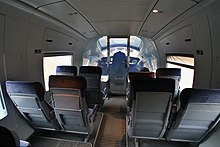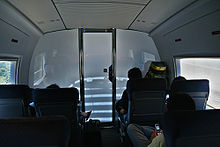Lounge (ICE)

The lounge is a compartment-like seating area to the ICE 3 - -T- and -T D - unit trains of Deutsche Bahn and in the after Spain , China and Russia delivered Velaro -Triebzügen. It is located directly behind the driver's cab and is only separated from it by a pane of glass. From slightly elevated seats, passengers can take a look at the route ahead and watch the driver as he controls the vehicle . The seats can be specifically reserved, but are not subject to any special reservation requirements.
construction
ICE lounges are designated as relaxation areas, which means that phone calls, loud conversations and the like are undesirable. Another special feature are the doors between the lounge and the adjoining entry area (vestibule). In order to avoid that passengers standing in front of the lounge (e.g. bystanders) open the door unintentionally, the sliding doors can only be opened from the outside by pressing a button (ICE 3) or touching them at a certain point (ICE T / TD). Most of the other sliding doors on the train open automatically by a motion detector .
The lounge is available in both end cars of the train, so that each multiple unit has a first class and a second class lounge. Contrary to the original plan, trains in double traction are not coupled in opposite directions, which would mean that only the first class lounges would be at the respective ends of the train with a clear view of the route; Instead, the second class lounge in one part and the first class lounge in the other are oriented towards the middle of the train. The number of seats varies between ICE 3 and ICE T / TD:
| ICE 3 | ICE T / TD | |
|---|---|---|
| First class: | 8 seats (No. 94-106, car 28/38) | 6 seats (No. 11–16, car 28/38/48) |
| Second grade: | 10 seats (No. 11-23, car 21/31) | 8 seats (No. 11-18, car 21/31/41) |
The seats in the lounges do not have footrests or newspaper nets. The seat spacing on the ICE 3 is slightly higher than in the open plan area. The ICE T, on the other hand, has the same seat spacing as in the open plan area (1st class: 1010 mm, 2nd class: 971 mm). Additional lights can be switched on and the interior temperature can be regulated using a regulator or switch above the entrance door. In the ICE-T there are luggage racks above the seats, in the ICE 3 storage areas in the rear area of the lounge.
history
The draft submitted by the Neumeister office as part of the design competition for the ICE 3 and ICE T in autumn 1994 provided for a semicircular seating group in the 2nd class of the ICE 3 directly behind the driver's cab, followed by two rows of four seats each. In 1st class on ICE 3, 2 × 4 and 2 × 2 seats should be arranged around tables. The original concept also provided for the train restaurant to be accommodated in one of the two lounges with semicircular seats. However, the railway board spoke out against this concept.
For the ICE-T it was originally planned to position the driver's cab above the passenger compartment, a few meters behind the front. More detailed studies showed that this would not be possible due to lack of space. Various other designs provided for a U-shaped seating group (with a passage in the center aisle) or seating with semicircular seating groups.
In order to prevent passengers from looking at the route at critical moments, automatic curtains and roller blinds were tested. After both test series were unsuccessful, the electrochromic glass used today became ready for series production in the mid-1990s .
The design of the mock-up of the ICE 3 lounge largely corresponded to the later series trains (1995)
In order to be able to implement the lounge concept, numerous functions that were still located in the rear wall of the driver's cab on the ICE 1 and ICE 2 were integrated into the two displays in the driver's cab. Other elements were arranged in cupboards on the side so as not to obstruct the view of the passengers. The basic arrangement of the controls on the driver's desk remained largely unchanged.
In the 15 new ICE multiple units of the 407 series (Velaro D) due for delivery around 2012 , the lounge will be dispensed with in favor of an engine room behind the driver's cab. According to DB, this step was “carefully weighed”, with advantages for maintenance, accessibility and concentration of all functions and devices in connection with the driver's cab ultimately being decisive. The passenger compartments could be structured in a "less restless" way. In addition, it would have been able to accommodate additional seats.
In the run-up to the ICE 3 redesign, many train drivers advocated making the windows of the partition permanently opaque.
How the pane of glass works
The pane of glass that separates the driver's cab from the lounge is usually transparent while driving, but can be switched to " milky " (largely opaque) using a button (see electrotropy ). In this way, passengers are also protected from "unwanted sights" such as a traffic accident . Strong incidence of light from behind or the driver's wish not to be seen are further reasons for switching the window.
The pane contains liquid crystals that are arranged in a preferred direction in an electric field and are therefore almost transparent - the pane generally appears somewhat cloudy. If there is no electric field, the crystals will not align and the pane will be milky. For this reason, the window automatically becomes opaque when the main switch of the train is switched off. The main switch is also designed for a short time at phase separation points , for example also at border crossings.
In the course of the conversion for Denmark traffic, the transparency of the separating panes in ten of the 19 ICE TDs was reduced by means of an affixed film.
According to a press report, Deutsche Bahn was unable to enforce plans against its works council to switch the pane regularly and transparently.
Web links
- fernbahn.de - Overview of the wagons of German long-distance trains. This page shows which car (and which lounge) is scheduled to run at the head of a particular train.
Individual evidence
- ↑ Zeno Pillmann: The 411/415 series - good idea, many problems. In: Lok Magazin , issue 1/2015, ISSN 0458-1822 , pp. 32–43.
- ^ Matthias Maier, Bernhard Rath, Volker Kottenhahn: Diesel-electric express multiple unit VT 605 (ICE-TD) for Deutsche Bahn AG . In: Eisenbahn-Revue International , Issue 10/2000, ISSN 1421-2811 , pp. 444–461.
- ↑ Elke Trappschuh: Faster, further, more beautiful . In: Alex Buck (Ed.): Alexander Neumeister. Designer monographs 8 . Verlag Form, Frankfurt am Main 1999, pp. 16–51.
- ↑ Armin Scharf: The ICE 3 and the German Pendolino . In: raised ground floor . 1997, No. 4, p. 36 f.
- ↑ Look ahead . In: Der Spiegel . Issue 7/1995, February 13, 1995, ISSN 0038-7452 , p. 92.
- ↑ Alexander Neumeister: The outer face . In: DB Reise & Touristik AG, ICE T consortium (ed.): ICE T. BR 411, 415 and 605 . Hestra-Verlag, Darmstadt 2000, ISBN 3-7771-0288-1 , pp. 24-27.
- ↑ a b Michael Krische: "An optimal compromise" . In: BahnExtra: 20 years of ICE . Issue 6, 2004, ISBN 3-89724-175-7 , pp. 48-52.
- ↑ Peter Lankes: The third generation: The ICE2.2 . In: Eisenbahn-Kurier , No. 278, November 1998, ISSN 0170-5288 , pp. 36-41.
- ↑ Heinz Kurz : InterCityExpress: The development of high-speed traffic in Germany . EK-Verlag, Freiburg 2009, ISBN 978-3-88255-228-7 , p. 222 f.
- ^ Frank Panier: New DB high-speed multiple units for international use . In: Eisenbahntechnische Rundschau , Issue 9/2010, September 2010, ISSN 0013-2845 , pp. 520-530.
- ↑ a b DB AG and Siemens present ICE 3 replica . In: Eisenbahn-Revue International . No. 6 , 2014, ISSN 1421-2811 , p. 170-174 .
- ↑ What will change for customers, train attendants and locomotive drivers? In: Ahead (Ed.): Ahead . No. 4 , April 2017, ISSN 1438-0099 , p. 24-26 .
- ↑ Walter Wille: A new chance for the troop from the siding . In: Frankfurter Allgemeine Zeitung , December 4, 2007, No. 282, p. T4



